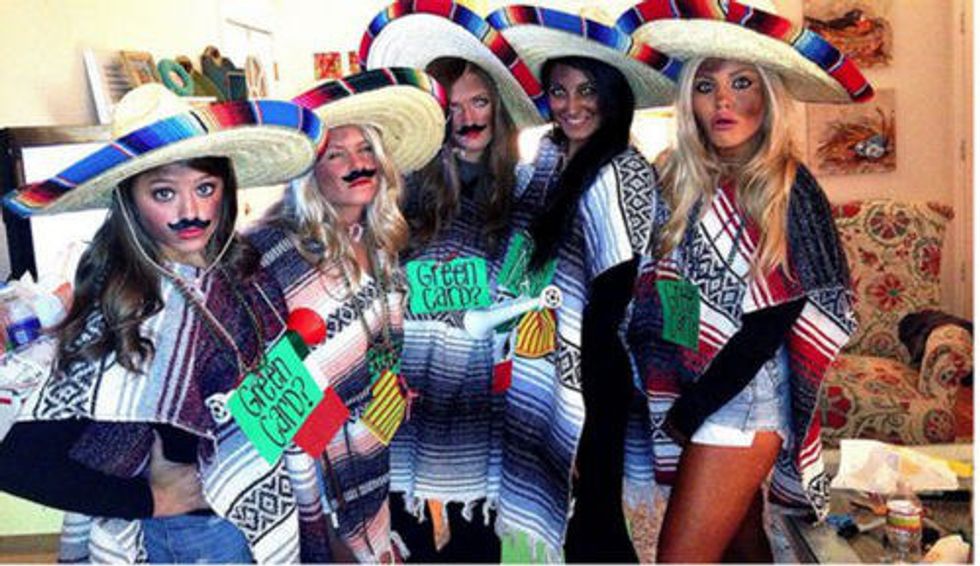The mainstream media has consistently overlooked Latinos for years. There aren’t many TV shows, movies, or books with a Latino main character, and if there is a Latino character, they usually act out stereotypes—such as being a housemaid (usually seen in female characters) or dealing/doing drugs (usually seen in male characters). Other stereotypes played out in movies and shows include Latinos posing as landscapers, criminals, and gang members. People dress up as "Mexicans" for Halloween or parties, further enforcing stereotypical ideas.
From 2012 to 2013, 17.7 percent of Latino movie characters and 24.2 percent of TV characters were linked to a crime, a large increase from 1996, where only 6 percent of T.V. characters were somehow involved with a crime. Additionally, 69 percent of maids in the media since 1996 are Latino.
According to the HuffPost Latino Voices, “Latino talent in top movie and television programming is extremely limited (less than two percent) and not increasing at a rate near the rise of the U.S. Latino population.” Not only are Latino leads currently almost nonexistent, but also there’s a low amount of Latinos in creative and leadership positions. Currently, 2.3 percent of directors and 2.7 percent of producers are Latino while only 6 percent of writers are Latino. The lack of Latino-themed content actually hurts big businesses, since they lose the interest of a large part of the U.S. population. The consequences of this are a lack of role models for a growing demographic, fewer jobs available to Latinos, and the enforcement of Latino stereotypes.
Latino representation gets even worse when it comes to the news--stories about Latinos, whether they be success stories or crime, are rarely seen in the media. In the past few years, there’s been a rise in the slogan “Black Lives Matter,” which is an important issue and one that I support wholeheartedly--but what about “Latino Lives Matter”? Killings of Latinos by police rarely make the news, even when it’s violent and the Hispanic person(s) in the matter is unarmed. There are 54 million Latinos in the U.S., and the media usually skims over the community.
For example, not many people have heard about Antonio Zambrano, a Mexican immigrant living in Washington who was shot to death by three police officers in February of 2015. The 35-year-old man was allegedly throwing rocks at passing cars when police fired on him. He was carrying only rocks when police shot at him 17 times, most of which actually missed him. The officers weren’t interviewed for another three months, and ended up not being charged with anything.
The most unfortunate part of this story is that people who did hear about this weren’t focused on the extreme violence of the officers, but on the fact that Zambrano was an immigrant. Many people, in defense of the officers, claimed that he wouldn’t have been killed if he had not come to the U.S.
Who knows how many similar stories are out there, and I didn’t hear about anyone protesting or claiming that Latinos lives matter too, or that Zambrano’s death was unjust.
And now Donald Trump wants to build a wall along the southern border to keep Mexican immigrants out of the country and immediately deport immigrants and their families. It’s part of the problem of mainstream media making Latinos appear as burdens in this country, and not as hardworking citizens or people looking for a better life. While illegal immigration is a problem, building a wall is not a sustainable solution. It’s a precarious situation.
I’m hoping that in these next few years, this “separate but equal” mindset diminishes greatly for every minority. If we truly want to fix the race problem in the U.S., we need to see more diverse movies, shows, and books and more minorities in leadership roles. We all have our roles as well--we need to support each other and work to make a difference, and not sit back and hope that someone else will do it for us.











 StableDiffusion
StableDiffusion StableDiffusion
StableDiffusion StableDiffusion
StableDiffusion Photo by
Photo by  Photo by
Photo by  Photo by
Photo by 
 Photo by
Photo by  Photo by
Photo by  Photo by
Photo by  Photo by
Photo by  Photo by
Photo by 








